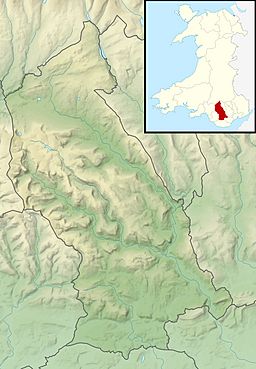Llyn Fawr facts for kids
Quick facts for kids Llyn Fawr |
|
|---|---|
 |
|
| Location | Rhigos, South Wales Valleys, Wales |
| Coordinates | 51°43′11″N 3°34′6″W / 51.71972°N 3.56833°W |
| Lake type | natural lake, reservoir |
| Basin countries | United Kingdom |
| Surface area | 9.8 ha (24 acres) |
| Surface elevation | 368 m (1,207 ft) |
Llyn Fawr, which means "Large Lake" in Welsh, is a beautiful lake and reservoir located in South Wales. It sits high up in the mountains, in a bowl-shaped valley called a glacial cirque, which was carved out by ancient glaciers. This area overlooks the Vale of Neath and the Cynon Valley.
Llyn Fawr is famous because an important collection of ancient weapons and tools was found here. These items date back to the very end of the Bronze Age and the beginning of the Iron Age.
The lake is part of a pair of these glacial valleys on the northern side of Craig y Llyn, a mountain that is a special protected area for nature. The other valley holds Llyn Fâch, meaning "Small Lake". Even though Llyn Fawr is in the Rhondda Cynon Taf area, its water naturally flows into the River Neath. Nearby, you can also find the beginnings of the Rhondda Fawr and Rhondda Fâch rivers.
Contents
Why Llyn Fawr Became a Reservoir
The Rhondda valley, located on the other side of the mountain from Llyn Fawr, grew very quickly during the coal mining boom. Its population jumped from under 1,000 people in 1851 to over 113,000 by 1901! This huge growth meant the valley needed a lot more water than its own rivers could provide.
To solve this problem, the Rhondda local council decided to turn Llyn Fawr into a reservoir in 1909.
How the Lake Was Expanded
Originally, Llyn Fawr was about 11.9 acres (0.048 square kilometers) in size. To make it bigger, workers built a 25-foot (7.6 meter) high embankment dam and also dug deeper into the lake bed.
By 1913, the work was finished. The new reservoir could hold 200 million gallons (909 million liters) of water and had a surface area of 21.6 acres (0.087 square kilometers). It was later made even larger, reaching 24.75 acres (0.100 square kilometers) by the 1970s.
Supplying Water to the Rhondda
The water from Llyn Fawr is pumped through a 1.25-mile (2 kilometer) long tunnel that goes right under Craig-y-Llyn. This tunnel leads to the Ty'n-y-waun Water Treatment Works in Tynewydd, Rhondda.
This tunnel is still a very important part of Welsh Water's system today. It provides most of the drinking water for the entire Rhondda valley. Engineers are currently looking into ways to keep the tunnel stable or even replace it, as it is sinking a bit due to old coal mines underneath.
The Ancient Llyn Fawr Hoard
The famous Llyn Fawr Hoard was discovered between 1909 and 1912, while workers were deepening the lake to create the reservoir. This collection of objects is incredibly important to understanding ancient times in Wales.
What Was Found in the Hoard?
The hoard contains many items from the late Bronze Age. What makes it truly special is that it also includes some of the earliest iron objects ever found in Wales.
- Iron Sword: The most notable iron item is a sword of the Hallstatt type, which is believed to be from around 650 BC. This is the oldest iron object found in Wales.
- Other Iron Tools: Two other iron tools were found: a spear and a socketed sickle (a curved blade used for cutting crops).
- Bronze Items: The hoard also included several bronze objects, such as two large cauldrons and several axeheads.
Why Were These Items in the Lake?
Experts believe that these items were not just lost. Instead, they were likely placed in the lake as votive offerings. This means people intentionally put them there as gifts to gods or spirits, perhaps as part of a religious ceremony or to ask for good fortune.
The discovery of this hoard was so significant that it gave its name to the "Llyn Fawr Phase." This is the name for the very last period of the Bronze Age in Britain. Today, the Llyn Fawr Hoard is kept and displayed by the National Museum Wales group, where you can learn more about it.


